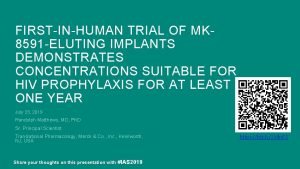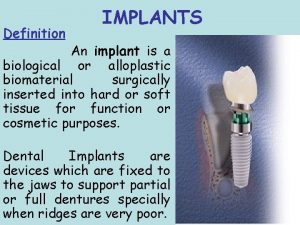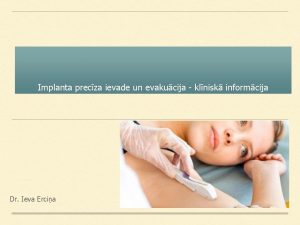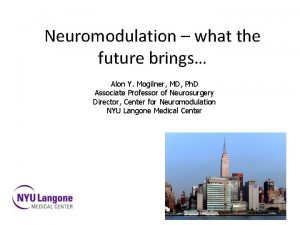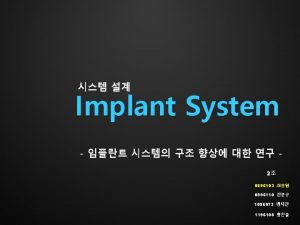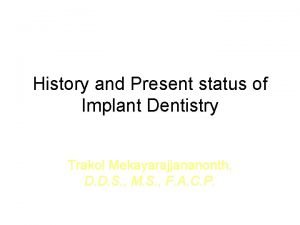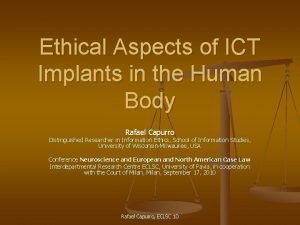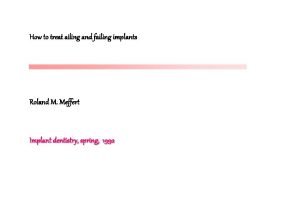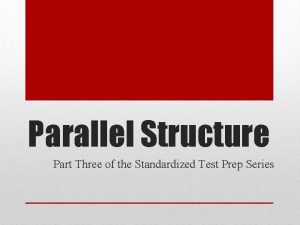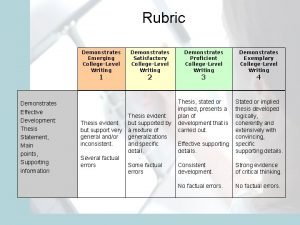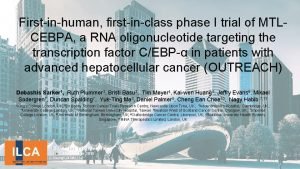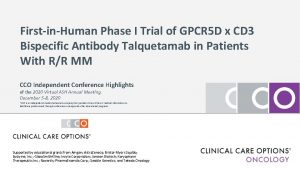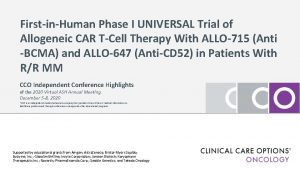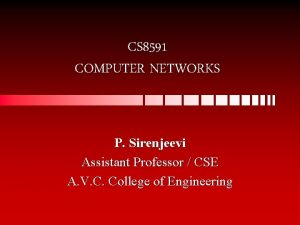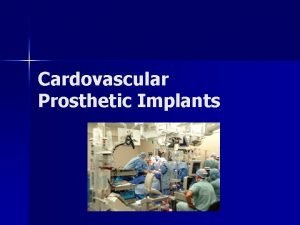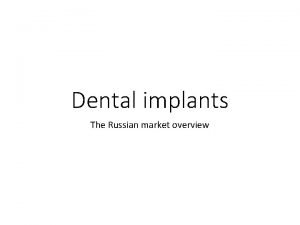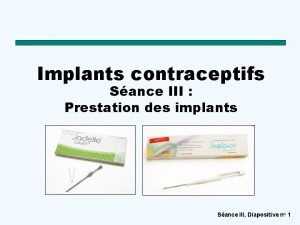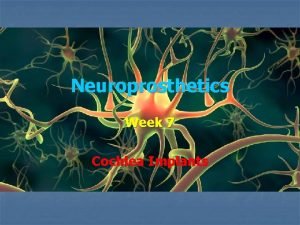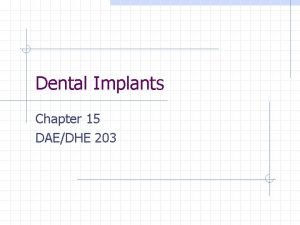FIRSTINHUMAN TRIAL OF MK 8591 ELUTING IMPLANTS DEMONSTRATES











- Slides: 11

FIRST-IN-HUMAN TRIAL OF MK 8591 -ELUTING IMPLANTS DEMONSTRATES CONCENTRATIONS SUITABLE FOR HIV PROPHYLAXIS FOR AT LEAST ONE YEAR July 23, 2019 Randolph Matthews, MD, Ph. D Sr. Principal Scientist Translational Pharmacology, Merck & Co. , Inc. , Kenilworth, NJ, USA Share your thoughts on this presentation with #IAS 2019 https: //bit. ly/2 Yjln. PG

Islatravir (MK-8591): A First-in-Class Nucleoside Reverse Transcriptase Translocation Inhibitor (NRTTI) With Multiple Mechanisms of Action Translocation Inhibition Due to the 4’-ethynyl Group Delayed Chain Termination Due to the 4’-ethynyl and 3’-hydroxyl Groups Multiple mechanisms contribute to the high potency of islatravir against HIV-1 and drug-resistant variants and its high barrier to resistance.

• Oral ISL administered to ~264 individuals to date – 144 healthy study participants, 30 treatmentnaïve persons living with HIV (PLWH) in Phase 1 • Single doses ≤ 400 mg, QD doses ≤ 5 mg x 6 weeks, QW doses ≤ 100 mg x 3 • Daily doses ≤ 2. 25 mg for 48+ weeks 100 10 1 0. 1 24 48 72 96 120 144 168 Time (hr) Grobler CROI 2016. • Oral Phase 1 development program – Generally well tolerated – Linear PK for both parent (plasma) and active triphosphate (TP) in PBMCs over a broad range • Half-life of parent ISL: 50 -60 hr • Half-life of active ISL-TP in PBMCs: 120 -177 hr – No effect of food on PK – Antiviral efficacy observed in monotherapy after single doses as low as 0. 5 mg – ISL-TP concentrations in rectal and vaginal tissue similar to PBMC concentrations at steady state 10 mg 30 mg 100 mg Week 3 Week 1 0 0 24 48 72 96 120 144 168 192 216 240 264 288 312 336 Time (hr) ISL 0. 5 mg ISL 1 mg ISL 2 mg ISL 10 mg ISL 30 mg 0. 0 Change From Baseline HIV-1 RNA (log 10 copies/m. L) – ~90 PLWH in Phase 2 ISL-TP Concentration in PBMC (pmol/106 cells) Islatravir (ISL) Clinical Development Overview -0. 5 -1. 0 -1. 5 -2. 0 -2. 5 0 Matthews IAS 2017. 2 4 6 Time (days) 8 10

ISL Implant Design Similar to Nexplanon® 2 mm • ISL implant based on Implanon®/Nexplanon® – Uses same polymer – Removable (not bioerodible) 4 cm • Able to use Nexplanon® applicator Nexplanon® • Initial trial uses prototype implant Polymer + ISL XRCT of ISL implant

Translational PK/PD Modeling Supports Pr. EP Exposure Threshold of 0. 05 pmol/106 Cells ISL-TP • Threshold of 0. 05 pmol/106 cells supported by: – ISL rhesus macaque SIV study – Efficacious concentrations at 0. 5 mg • 0. 05 pmol/106 cells = ~5. 0 x in vitro IC 50 – In vitro WT IC 50 of ISL-TP is ~0. 01 pmol/106 cells – 0. 05 pmol/106 cells ISL-TP also covers in vitro IC 50 for M 184 I/V Goal is to maintain concentrations above 0. 05 pmol/106 cells for the entire duration of implant placement

Study Design • Double-blind, placebocontrolled trial in healthy individuals – Panel A: 54 mg – Panel B: 62 mg • Eight (6 + 2 design) per panel • Implant placed subdermally in upper arm of nondominant hand • Implant in place 12 weeks, followed by 4 weeks postremoval • PK (plasma and PBMC), ECGs, vital signs, safety labs collected throughout Study Objectives • Assess safety and tolerability of an islatravireluting implant placed for 12 weeks • Characterize the PK profiles of ISL and ISLTP, and estimate the time at which the concentration of ISL-TP would fall below 0. 05 pmol/106 cells

Intracellular ISL-TP PK Threshold of 0. 05 pmol/10 6 Cells Maintained Throughout Placement for Both Doses 62 mg Implant ISL-TP (pmol/106 cells) 54 mg Implant • Ratio of TP/plasma remains fairly constant at ~1000: 1 – consistent with oral dosing • Half-life after removal of implant similar to half-life of orally dosed ISL

62 mg Implant Projected to Lead to Concentrations Above Threshold for at Least 12 Months ISL plasma concentrations (µM) 0. 06 0. 04 0. 02 0. 00 ISL-TP concentrations (pmol/10 6 cells) 0. 08 • 62 mg implant will continue to release through 52 weeks • ISL-TP should be above threshold (0. 05 pmol/10 6 cells) for >12 months – Projected concentration at 12 months: 0. 076 pmol/106 cells – Projected time at which concentration falls below 0. 05 pmol/10 6 cells: 68 -70 weeks (~16 months)

Safety Summary Generally Mild Local Tolerability Effects; No Systemic Effects Noted • Implants generally well tolerated through 12 weeks – – 16/16 subjects reported at least 1 adverse event (AE) All drug-associated AEs were mild or moderate in severity No serious AEs and no discontinuations due to an AE Types of AEs observed consistent with those observed with other implants; hematoma and pain/tenderness generally noted after placement or removal procedure Adverse Event (mild unless noted) Placebo (N=4) 54 mg Implant (N=6) 62 mg Implant (N=6) Implant site hematoma 4 (100%) 6 (100%) Implant site pain/tenderness 2 (50%) 3 (50%); 1/3 moderate 6 (100%); 2/6 moderate Implant site erythema 0 (0%) 2 (33%) 5 (83%); 1/5 moderate Implant site induration 0 (0%) 5 (83%) 6 (100%) Implant site pruritus 1 (25%) 0 (0%) 5 (83%) • In pooled analysis of vital signs, ECG parameters, and safety laboratory studies, there were no clinically significant differences between the placebo group and the 2 implant groups • No clinically significant outlying values in any individual set of vital signs, ECG parameters, or safety laboratory studies

Conclusions • ISL prototype implants were generally well tolerated, with no discontinuations due to an AE and no severe implant-related AEs – No laboratory or other signs of systemic reactions – Local tolerability (erythema, induration) generally mild and possibly dose dependent • Both implants (54 and 62 mg) had concentrations above PK threshold at 12 weeks – 62 mg implant projected to be well above threshold at 12 months and likely for several months beyond Supports potential of the ISL implant as a once-yearly Pr. EP option

Acknowledgments Biopharmaceutics Translational Pharmacology • Wei Zhu • Vanessa Levine Global Clinical Development • Guo Chen • Mike Robertson • Liesbeth Haspeslagh Discovery Biology https: //bit. ly/2 Yjln. PG • Marian Iwamoto • Jay Grobler • Aubrey Stoch Safety Assessment and Pharmacokinetics/Pharmacodynamics Drug Research Unit Laboratory Animal Resources and Drug Metabolism Ghent • Ray Gonzalez • Munjal Patel • Sylvie Rottey (PI) Regulatory Affairs • Kerry Fillgrove • All the study • Anita Shaw • Melanie Anderson participants Project Management • Ryan Vargo • Nathan Kreischer Biostatistics • Sandra Zhang Implant Formulation Merck Sharp & Dohme Corp. , a subsidiary of Merck & • Stephanie Barrett Co. , Inc. , Kenilworth, NJ, USA, provided financial support for the study.
